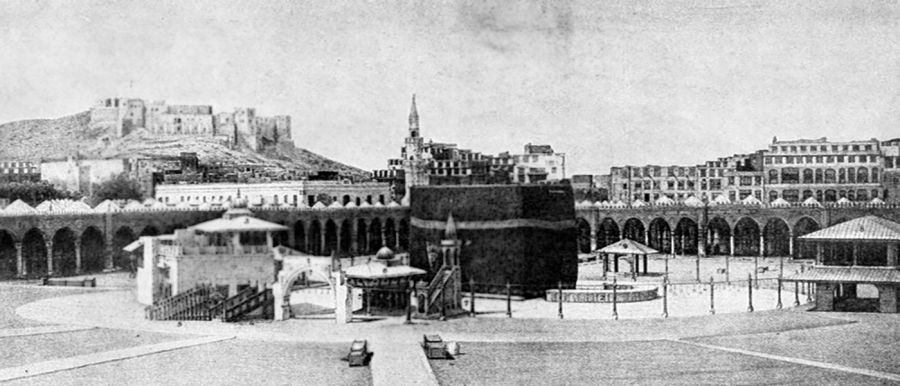The word Kaaba means cube in Arabic, and it refers to the square-like building in the holy city of Mecca, which is covered with a silk and cotton veil. It is the most sacred site for Muslims, and millions of people travel to visit that as a pilgrim each year.
Many people think that Kaaba was built at the time of Prophet Muhammad (PBUH&HP) and with the advent of Islam. However, history has a different narration about which we are going to talk in this article.
1. The First People who Built Kaaba
The first person who built Kaaba was Adam (PBUH), and it was remained unharmed until the great flood at the time of Noah (PBUH) [1], which caused it to be partially damaged. Afterward, the structure of the Kaaba was reconstructed by prophet Abraham (PBUH) and his son, Ishmael, under the command of Allah. The Quran has narrated this story in this verse:
As Abraham raised the foundations of the House with Ishmael, [they prayed]: 'Our Lord, accept it from us! Indeed, You are the All-hearing, the All-knowing. (2: 127)

2. Kaaba Between Abraham (PBUH) and Prophet Muhammad (PBUH&HP)
The son of prophet Abraham (PBUH), Ishmael (PBUH), and a tribe named Jorohom were the guardians of Kaaba after the demise of prophet Abraham (PBUH). This magnificent building stood upright until that Jarhim tribe, and then a tribe named Amaaleh rebuilt the square-shaped holy place [2]. Years after, one of the predecessors of Prophet Muhammad (PBUH&HP) named Qusai Bin Kelab, made a wooden structure to protect the building and neighbored it with another building Called Dar-ol Nadvah, which was the governor's state. Then he asked each Quraysh tribe to locate their houses mirroring one side of the Kaaba, to build a circle around it. Some say that Kaaba was once ruined in flood before the time of Prophet Muhammad (PBUH&HP), but that again is not proven [3].
3. Kaaba and Prophet Muhammad (PBUH&HP)

When Prophet Muhammad (PBUH&HP) was chosen as the Messenger of Allah, Kaaba was considered a holy place. Some reference books say that Prophet Muhammad (PBUH&HP) took part in the reconstruction of the Kaaba after the flood. Also, there was a fight between the Arab clans about where to locate the Black Stone, and Prophet Muhammad (PBUH&HP) was chosen as the trustee of all clans to locate the holy stone on the eastern side's edge. (4) Kaaba was filled with idols and statues when Prophet Muhammad (PBUH&HP) left Mecca because of the severe tortures and problems the Arab clans made for him and his followers. Even years before, Kaaba was a place to worship the idols.
When Prophet Muhammad (PBUH&HP) gathered his followers and returned to Mecca, he ruined all those idols with the help of his first follower and friend, Imam Ali Ibn Abi Talib (AS). Kaaba became a center of performing Hajj and the Qibla [i] of the Muslims. The Dome of Rocks (Qubbat al-Ṣakhrah ) was the first Qibla of Muslims, but Allah inspired Prophet Muhammad (PBUH&HP) to change it toward the Cubic Kaaba.
4. Kaaba After Prophet Muhammad (PBUH&HP)
Kaaba has been reconstructed many times after the demise of Prophet Muhammad (PBUH&HP), but the cubic shape of the building has never been changed. Now, the Saudi Arabian Government is responsible for preserving this sanctuary, though it belongs to all Muslims and all nations. There are many different parts and holy sites around Kaaba, like the Black Stone, the Iraqi corner, the Kiswa, or the black covering, which we are going to discuss in our next articles.
Notes:
[i] Qibla is the direction to which all Muslims say their prayers.
References:
[1] Arzaghi, Abu Valid Kaaba News and What happened to that, Vol. 1, P 68.
[2] Seyyed Hashem Bahrani,Tafsir Al-Burhan Vol. 1 P 301 Hadith 36.
[3] Rasouli Mahallati, Hashim Analytical History of Islam (2), (1991) Tehran, Iran.
[4] Guillaume, A. (1955). The Life of Muhammad. Oxford: Oxford University Press. pp. 84–87.


















